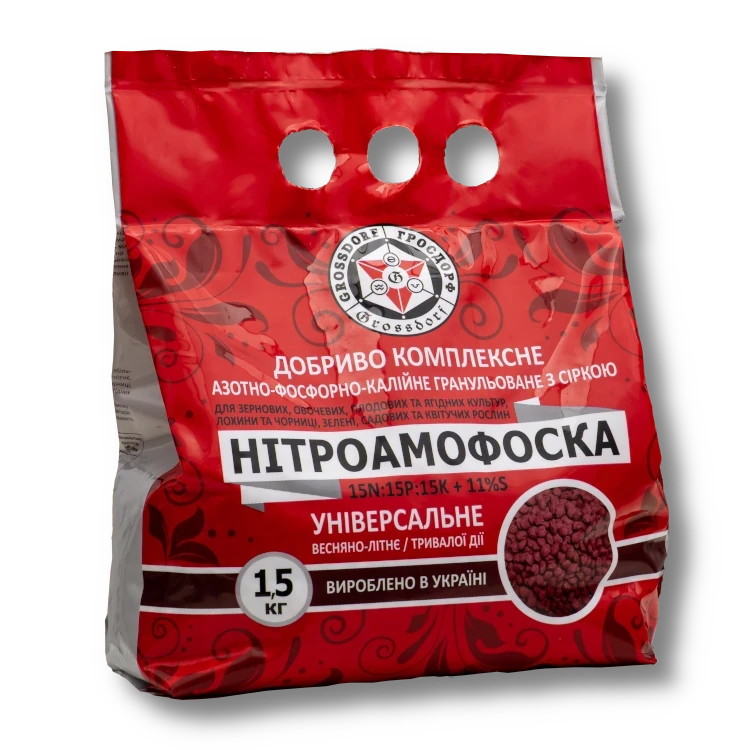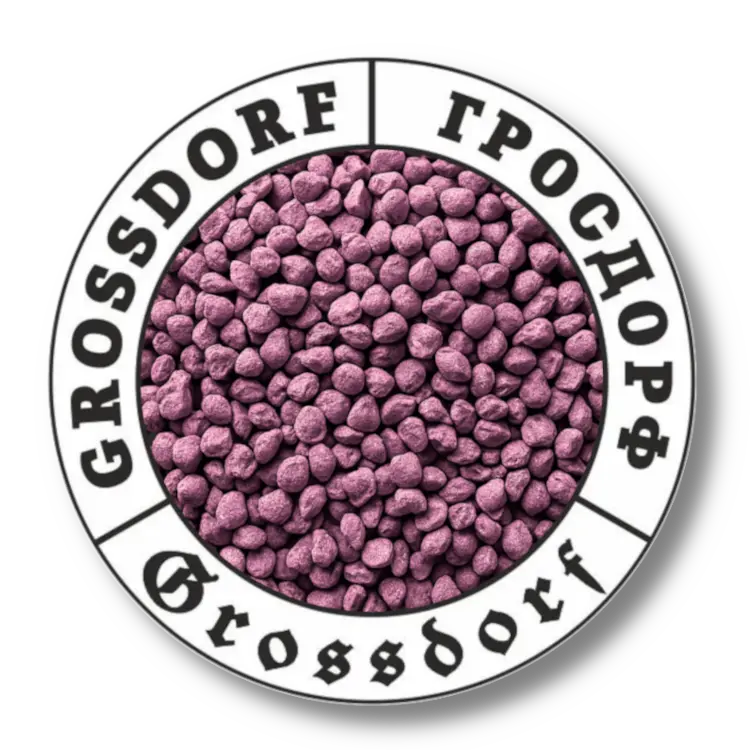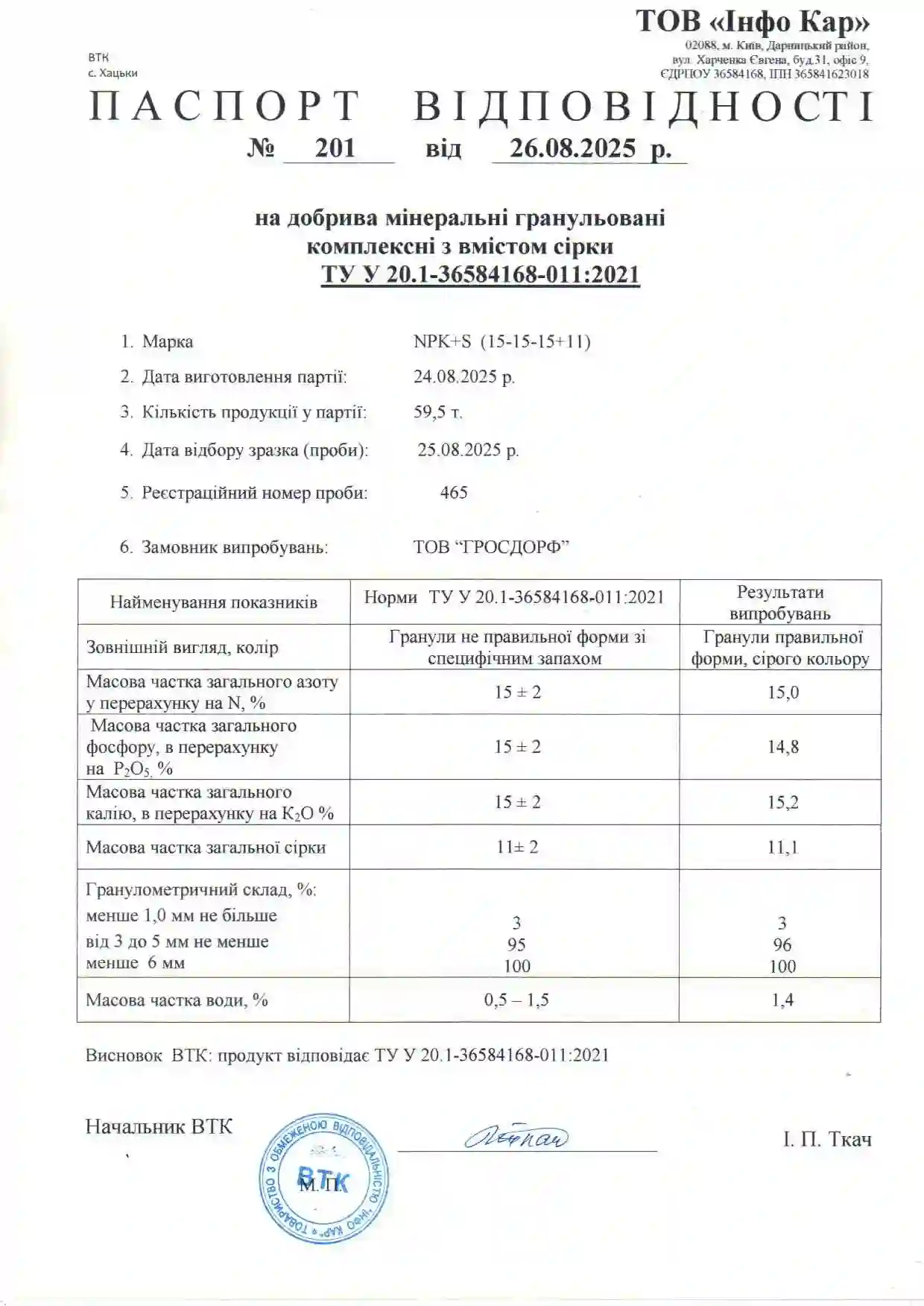Nitroammophoska N15:P15:K15+11S
Granulated complex mineral fertilizer
with sulfur content “NPK+S 15:15:15+11”
TU U 20.1-36584168-011:2021
Sales/packing terms: EXW, FCA, retail packaging 1.5 kg
Delivery terms: own transport across Ukraine or self-pickup
72 UAH
Nitroammophoska N15:P15:K15+11S is a versatile complex fertilizer with a balanced content of the three primary nutrients: nitrogen (N), phosphorus (P₂O₅), and potassium (K₂O) — each at 15%, as well as 11% sulfur in the form of sulfate (SO₃), which is readily available for plant uptake.
With a neutral pH (5.5–6.5), it does not acidify the soil and is suitable for use across a wide range of agricultural soils — from chernozems to sandy loams and acidic soils.
The sulfur in the formulation:
- enhances protein, enzyme, and chlorophyll synthesis;
- boosts nitrogen uptake;
- improves product quality (protein, gluten, oil content, amino acids).
Recommended use
- suitable for all crops: cereals, oilseeds, technical crops, fodder crops, vegetables, root crops, fruit trees, berries, flowers/lawns, and conifers;
- for basal application in autumn or spring;
- pre-sowing incorporation into the soil;
- localized or row application.
Advantages
- balanced three-component (NPK) formula — optimal starter nutrition for any crop;
- high sulfur content — improves nitrogen efficiency and crop quality;
- universal application — suitable for most soils and climatic zones;
- uniform granules — precise dosing and even distribution;
- minimal nutrient loss during transportation and storage.
Limitations and warnings:
- not recommended for use on waterlogged, highly acidic soils without prior liming;
- avoid storing with alkaline or organic fertilizers.
Appearance and сolor: irregularly shaped granules with a characteristic odor
| Mass fraction of total nitrogen in terms of N, % | 15 ± 2 |
| Mass fraction of total phosphorus in terms of P₂O₅, % | 15 ± 2 |
| Mass fraction of total potassium in terms of K₂O, % | 15 ± 2 |
| Mass fraction of total sulfur, % | 11 ± 2 |
| Granulometric composition, % | |
| Less than 1.0 mm or more | 3 |
| 3 to 5 mm not less than | 95 |
| less than 6 mm | 100 |
- store in dry, well-ventilated facilities, protected from direct sunlight, with relative air humidity not exceeding 70%. Place bags on pallets at least 15 cm above the floor, arranged in a single layer;
- packaging (bags, big bags) must be tightly sealed to prevent moisture ingress;
- permissible storage temperature: from –20 °C to +35 °C (avoid exposure to high humidity, as this may cause caking or condensation — loosen before use if necessary);
- avoid contact with acids, alkaline substances, organic compounds, or other fertilizers that may cause a chemical reaction;
- in case of prolonged storage, periodically loosen the product to prevent clumping.
Storage guarantee period: the shelf life of the fertilizer, provided that transportation and storage conditions are observed, is 12 months from the date of manufacture. After the expiration of the guaranteed storage period, the fertilizer must be tested for compliance with technical specifications before use.
| Crop | Application period/rate (kg/are) | Special application conditions | ||
|---|---|---|---|---|
| Pre-sowing cultivation | First fertilization | Second fertilization | ||
| Cereal сrops | ||||
| Winter wheat | 2,3–4,5 | - | - | in autumn under plowing/digging |
| - | 0,6–0,9 | - | at sowing, into the rows | |
| Spring barley | 3,0–4,0 | - | - | in autumn, under plowing or digging, or before sowing |
| - | 0,7–1,0 | - | at sowing, into the rows | |
| Corn | 4,0–6,0 | - | - | before sowing |
| 6,0–7,0 | - | - | in autumn, during plowing/digging | |
| - | 0,3–0,7 | - | at sowing, into the rows | |
| Oats | 3,0–4,0 | - | - | in autumn under plowing/digging or before sowing |
| - | 0,7–1,0 | - | at sowing, into the rows | |
| Industrial crops | ||||
| Sunflower | 3.0 | — | — | apply during primary tillage or before sowing |
| 1,0 | - | - | at sowing, into the rows | |
| Soybean | 2,0 | - | - | during primary tillage or before sowing |
| 1,0 | - | - | at sowing, into the rows | |
| Sugar beet | 5,0 | - | - | during primary tillage or before sowing |
| 1,0 | - | - | at sowing, into the rows | |
| Oilseeds | ||||
| Winter rapeseed | 4,0–6,0 | - | - | before fall (primary) tillage or prior to sowing |
| 0,7–1,0 | - | - | at sowing, into the rows | |
| - | 1,0–4,6 | - | spring vegetation recovery | |
| Oil Flax | 3,0 | - | - | during autumn (fallow) tillage or before sowing |
| 1,0 | - | - | at sowing, into the rows | |
| Vegetables | ||||
| Tomatoes | 1,0 | - | - | during seedling transplanting |
| - | 1,3 | - | 10 to 12 days after seedling transplanting | |
| - | - | 1,3 | during flowering | |
| Peppers | 1,3 | - | - | during seedling transplanting |
| - | 1,3 | - | 10 to 12 days after seedling transplanting | |
| - | - | 1,3 | during flowering and fruit formation stages | |
| Zucchini | 1,0 | - | - | at sowing, into the rows |
| - | 1,3 | - | during flowering | |
| - | - | 1,3 | at the beginning of fruiting | |
| Cucumber | 0,7 | - | - | at sowing, into the rows |
| - | 1,3 | - | at the 3–4 leaf stage | |
| - | - | 2,0 | complete before vine spreading begins | |
| Eggplant | 1,0 | - | - | at sowing, into the rows |
| - | 1,3 | - | 10 to 12 days after seedling transplanting | |
| - | - | 1,3 | 10–12 days after the first fertilization | |
| Potatoes and other root crops | ||||
| Potatoes | 4,0–6,0 | - | - | in autumn under plowing/digging or before planting |
| 0,3–0,7 | - | - | at sowing, into the rows | |
| Table Beet (Beetroot) | 4,0–6,0 | - | - | in autumn under plowing/digging or before sowing |
| 1,3 | - | - | at sowing | |
| Carrot | 4,0–6,0 | - | - | in autumn under plowing/digging or before sowing |
| 1,3 | - | - | at sowing | |
| Radish | 4,0–6,0 | - | - | in autumn under plowing/digging or before sowing |
| 1,0 | - | - | at sowing | |
| Onion | 4,0-6,0 | - | - | before plowing or during pre-sowing cultivation, if no further fertilization is planned |
| 0,7 | - | - | at sowing, into the rows | |
| - | 1,3 | 10–14 days after emergence | ||
| - | - | 1,3 | at the bulb formation stage | |
| Garlic | 6,0 | - | - | during plowing |
| 1,0 | - | - | at sowing, into the rows | |
| - | 0,7 | - | at the beginning of clove formation | |
| Fruit trees and berry trees | ||||
| Apple tree | 6,0 | - | - | fertilization in early spring or autumn |
| Pear tree | 4,5–5,0 | - | - | fertilization in early spring or autumn |
| Cherry tree | 6,0 | - | - | fertilization in early spring or autumn |
| Raspberry | 4,0–5,0 | - | - | fertilization in early spring or autumn |
| Wild Strawberry/Garden Strawberry | 4,0 | - | - | fertilization in early spring or autumn |
| Grapes | 3,5–4,0 | - | - | fertilization in early spring or autumn |
| Blueberry | Fertilization should be carried out twice a year: at the beginning of the growing season (April) and at the end (August–September). After planting: 2nd year – 1 tablespoon, 3rd year – 2 tablespoons, 4th year – 4 tablespoons, 5th year – 8 tablespoons, 6th year and beyond – 16 tablespoons or 40–50 g per mature bush | |||
| Flowers and lawn grasses | ||||
| Rose | 0,03 | - | - | into the planting hole |
| 6,0–10,0 | - | - | before deep soil tillage | |
| - | 0.015–0.02 per 10 liters of water | - | after pruning and before the emergence of the first leaf | |
| - | - | 0,010-0,015 per 10 liters of water | during the period of active growth, full bloom, and second flowering | |
| Tulip | 7,0 | - | - | one month before planting |
| - | - | 3,0 | Fertilization at the bud formation stage into furrows 8–10 cm deep between plant rows, followed by incorporation into the soil. | |
| Lawn Grasses | 4,0 | - | - | in autumn before lawn establishment |
| - | 2,5-3,0 | spring or summer fertilization (June–August) | ||
| Conifers | ||||
| Самшит | 4,0 | - | - | in spring (April–May) at 40 g/m² |
| 3,0 | - | - | at planting, into the hole, 30 g/m² | |
| Juniper | 3,0-4,0 | - | - | in spring (April–May) at 30-40 g/m² |
| 2,5 | - | - | at sowing, into the hole, 25 g/m² | |
| Thuja | 3,0-4,0 | - | - | in spring (April–May) at 30-40 g/m² |
| 2,5 | - | - | at planting, apply 25 g/m² into the planting hole | |
The fertilizer application rates were developed by the Department of Agrochemistry and Soil Science of Uman National University of Horticulture under the scientific supervision of Doctor of Agricultural Sciences, Professor Hospodarenko H.M., commissioned by AC Grossdorf. These recommendations are the intellectual property of AC Grossdorf and may be distributed only with proper attribution to the owner.
The provided application rates are generalized and do not replace the need for consultation with an agronomist.


